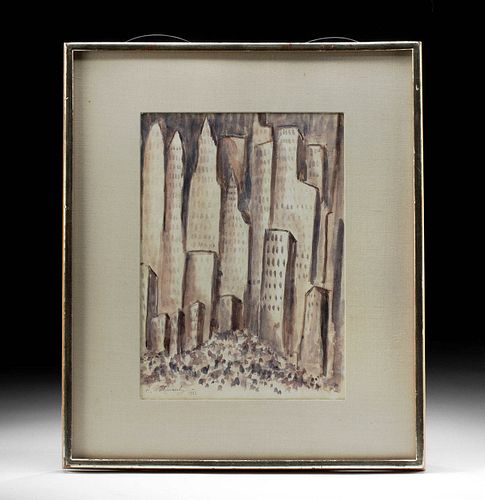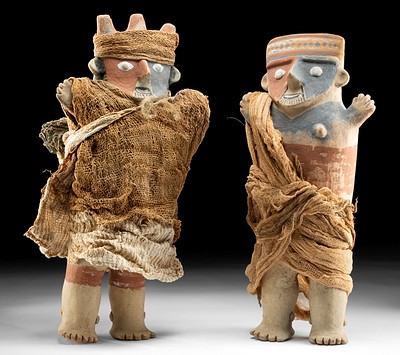Abraham Walkowitz Watercolor - "New York City" (1912)
Lot 148
About Seller
Artemis Gallery
686 S Taylor Ave, Ste 106
Louisville, CO 80027
United States
Selling antiquities, ancient and ethnographic art online since 1993, Artemis Gallery specializes in Classical Antiquities (Egyptian, Greek, Roman, Near Eastern), Asian, Pre-Columbian, African / Tribal / Oceanographic art. Our extensive inventory includes pottery, stone, metal, wood, glass and textil...Read more
Categories
Estimate:
$2,000 - $4,000
Absentee vs Live bid
Two ways to bid:
- Leave a max absentee bid and the platform will bid on your behalf up to your maximum bid during the live auction.
- Bid live during the auction and your bids will be submitted real-time to the auctioneer.
Bid Increments
| Price | Bid Increment |
|---|---|
| $0 | $25 |
| $300 | $50 |
| $1,000 | $100 |
| $2,000 | $250 |
| $5,000 | $500 |
| $10,000 | $1,000 |
| $20,000 | $2,500 |
| $50,000 | $5,000 |
| $100,000 | $10,000 |
| $200,000 | $20,000 |
About Auction
By Artemis Gallery
May 19, 2022
Set Reminder
2022-05-19 10:00:00
2022-05-19 10:00:00
America/New_York
Bidsquare
Bidsquare : Fine Antiquities | Ethnographica | Fine Art
https://www.bidsquare.com/auctions/artemis-gallery/fine-antiquities-ethnographica-fine-art-9350
Featuring a very special collection of Fine Art from the Hollywood Hills, including Picasso & Rookwood ceramics! Also included are many fine examples of classical antiquities, ancient, and ethnographic art from cultures encompassing the globe. Artemis Gallery info@artemisgallery.com
Featuring a very special collection of Fine Art from the Hollywood Hills, including Picasso & Rookwood ceramics! Also included are many fine examples of classical antiquities, ancient, and ethnographic art from cultures encompassing the globe. Artemis Gallery info@artemisgallery.com
- Lot Description
Abraham Walkowitz (American born in Russia, 1878-1965). "New York City" watercolor on paper, 1912. Signed and dated in pencil on lower left. A magnificent example of Abraham Walkowitz's masterful interpretations of New York City's palpable energy and modernity, this avant garde cityscape demonstrates the vocabulary, structure, and gesture of Walkowitz's visual language which conveyed his penchant for geometry, lyrical line, and improvisation. While his approach drew influences from modern masters such as Cezanne, he created is own unique style that would inspire future generations of artistic innovators including the Abstract Expressionists. Size of sight view: 11.5" L x 8.125" W (29.2 cm x 20.6 cm) Size of frame: 17.125" L x 14.375" W (43.5 cm x 36.5 cm)
According to curator Patrick Shaw Cable, "Walkowitz's most important legacy is arguably his masterful and wide-ranging draftsmanship...The bold ink New York Abstraction illustrates ...a major theme and mode of expression for Walkowitz-the vital dynamism and power of the modern metropolis, translated in an anthropomorphic way through dense arrangements of simplified forms and rushing lines....The simultaneously organic and geometric composition reminds us of the following words used by historian Gail Levin to summarize Walkowitz's modernist contribution, 'Walkowitz was among the first American artists...to develop a personal, lyrical abstract style based on [Kandinsky's] principles. Walkowitz suggests continuity between the first American avant-garde and the Abstract Expressionists'" (Modern American Painting 1907-1936: The Maria and Barry King Collection, exhibition catalogue, El Paso Museum of Art, El Paso, Texas, 2013, pp. 73-74).
Many Americanists agree that Abraham Walkowitz was the first artist to exhibit indisputably Modernist paintings in the US. Walkowitz exhibited at the Little Galleries of the Photo-Secession, the New York Armory Show of 1913 where he had 12 works accepted to exhibit, a well as the 1916 Forum Exhibition. Also a regular at Alfred Stieglitz's famous 291 gallery, Walkowitz passionately engaged in debates about modern art in America, supporting experimentation in the arts that fueled Modernism. In addition, Walkowitz affiliated himself with fellow Modernists Arthur Dove, John Marin, and Marsden Hartley in New York City. Hartley actually introduced Walkowitz to Alfred Stieglitz in 1911, and Walkowitz' art was exhibited four times at 291 between 1912 and the gallery's closing in 1917. In addition, Walkowitz is known for his drawings of the avant garde dancer Isadora Duncan. Max Weber introduced them in Auguste Rodin's studio, and Walkowitz went on to crete over 5,000 drawings of Duncan whose dancing was regarded as the epitome of modern expression. In Walkowitz's words, "She (Duncan) had no laws. She did not dance according to the rules. She created. Her body was music. It was a body electric, like Walt Whitman." (Lerner, Abram, and Bartlett Cowdrey. "Oral History Interview With Abraham Walkowitz." 8 Dec. & 22 Dec. 1958. Smithsonian Archives of American Art)
Provenance: private Boulder, Colorado, USA collection
All items legal to buy/sell under U.S. Statute covering cultural patrimony Code 2600, CHAPTER 14, and are guaranteed to be as described or your money back.
A Certificate of Authenticity will accompany all winning bids.
PLEASE NOTE: Due to recent increases of shipments being seized by Australian & German customs (even for items with pre-UNESCO provenance), we will no longer ship most antiquities and ancient Chinese art to Australia & Germany. For categories of items that are acceptable to ship to Australia or Germany, please contact us directly or work with your local customs brokerage firm.
Display stands not described as included/custom in the item description are for photography purposes only and will not be included with the item upon shipping.
#171216This watercolor has not been examined outside the frame but appears to be in excellent condition. It is signed and dated in pencil by the artist on the lower left. On the verso cardboard is a label that reads, "New York City A. Walkowitz" and the name of former owner Herbert Friedwald is handwritten. The frame shows a few scuffs/nicks commensurate with age. It is wired for suspension.Condition
- Shipping Info
-
All shipping is handled in-house for your convenience. Your invoice from Artemis Gallery will include shipping calculation instructions. If in doubt, please inquire BEFORE bidding for estimated shipping costs for individual items.
-
- Buyer's Premium



 EUR
EUR CAD
CAD AUD
AUD GBP
GBP MXN
MXN HKD
HKD CNY
CNY MYR
MYR SEK
SEK SGD
SGD CHF
CHF THB
THB














